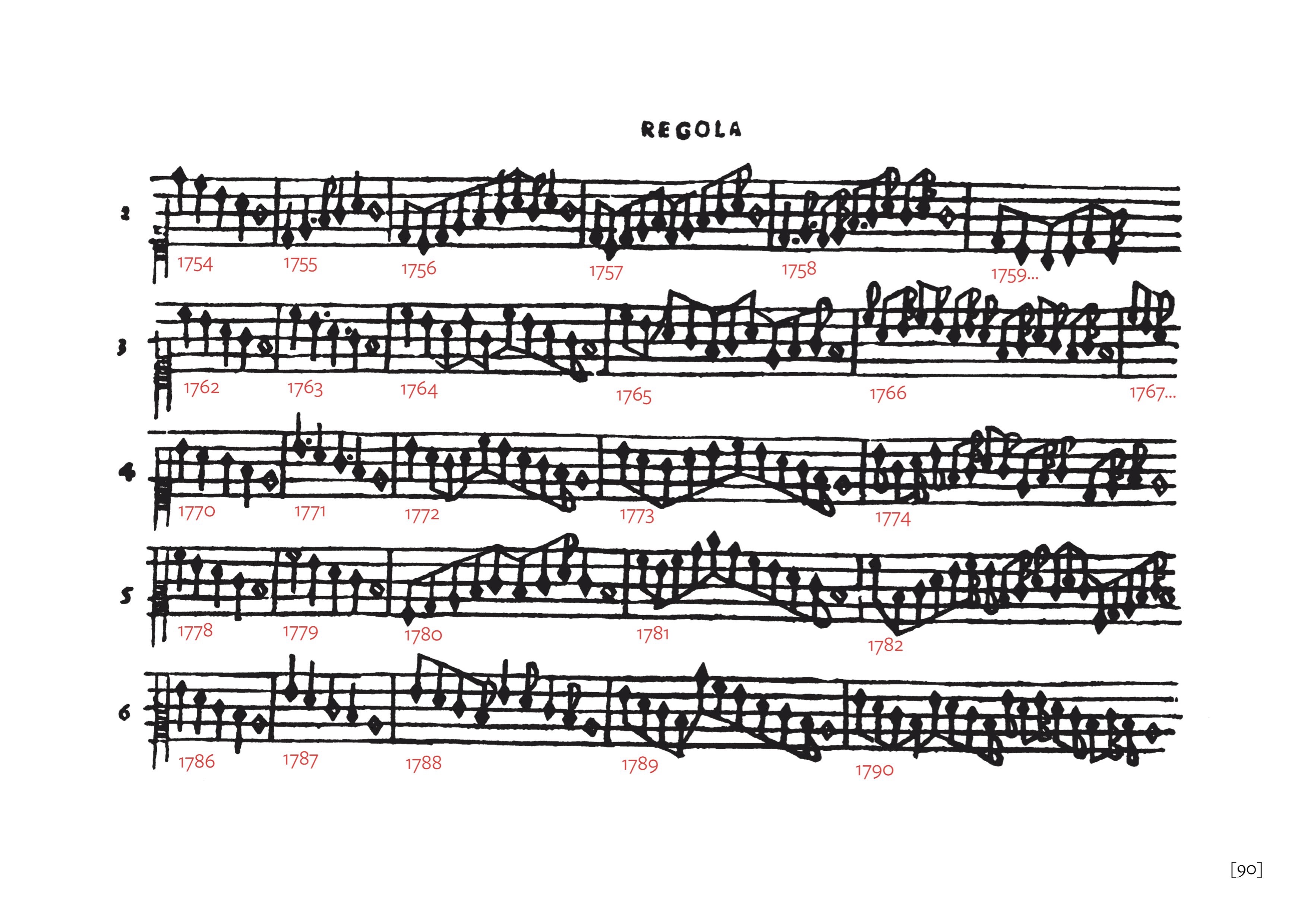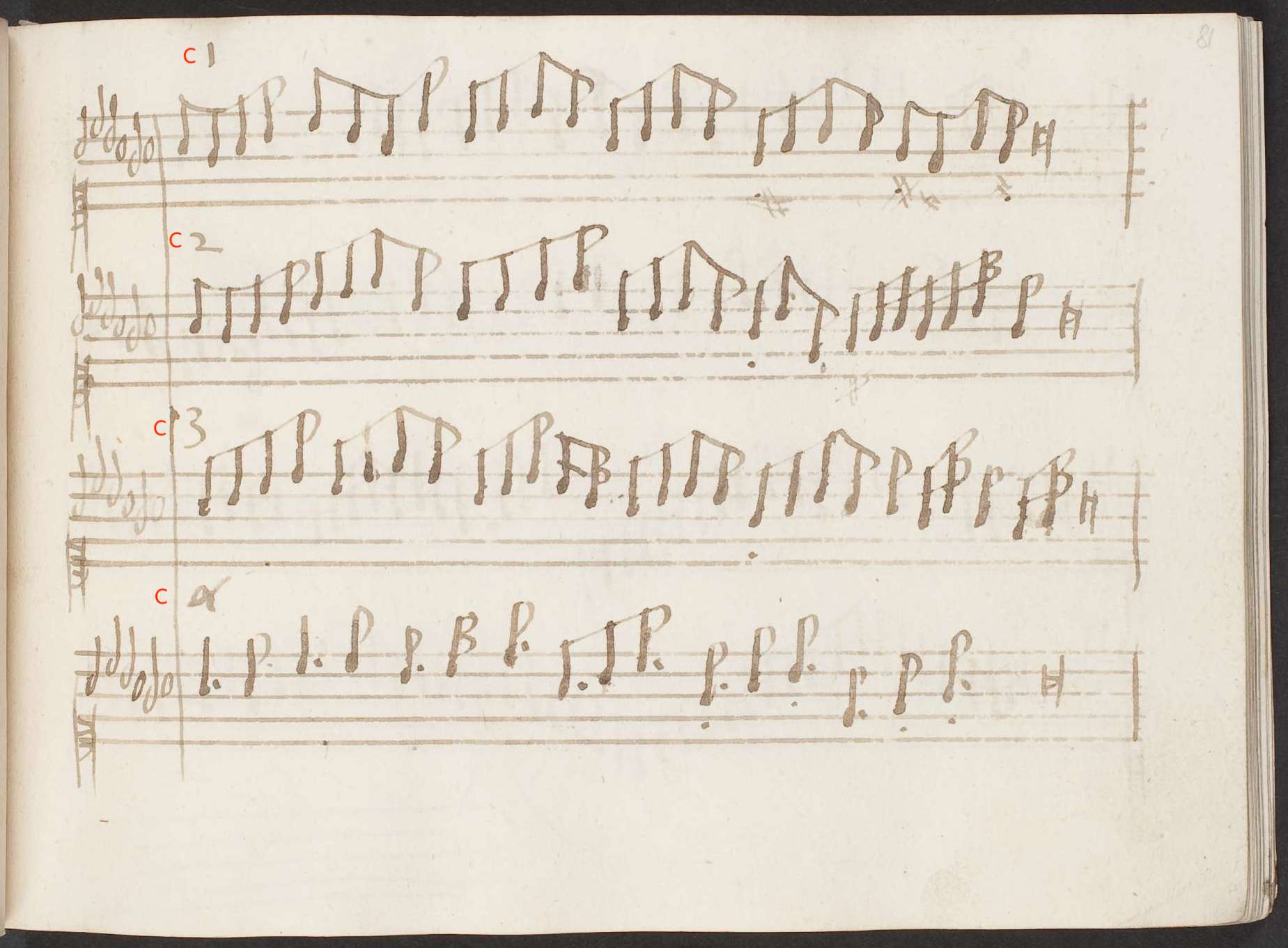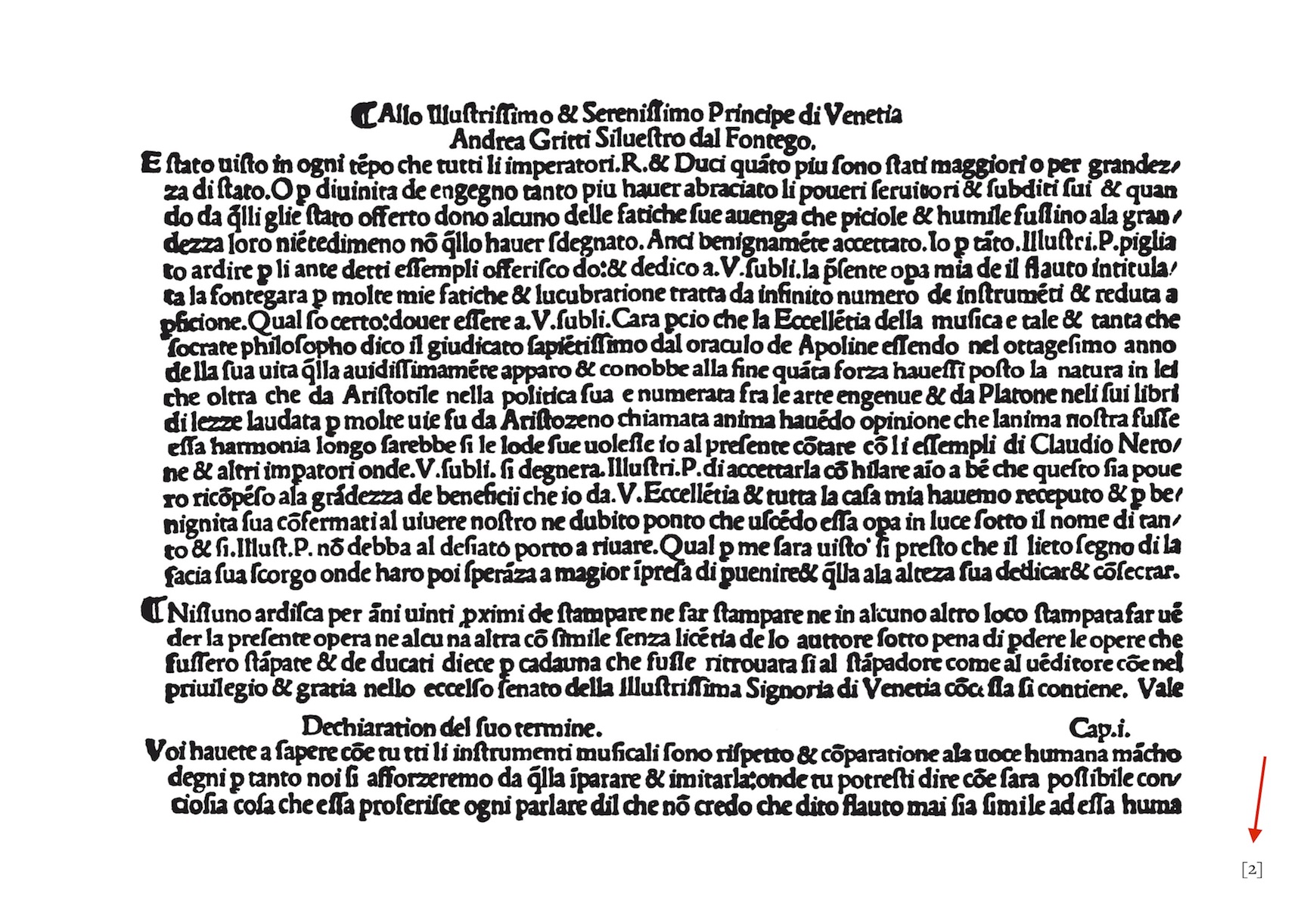Numbering Ganassi’s Works
A note on page numbers
The Regola Rubertina (1542) is the only Ganassi publication that originally contained page numbers (from I–L, 1–50). Except for the quire signatures, the 70-page Lettione seconda (1543) is unnumbered, as is the 158-page Fontegara (1535),[^1] which makes it very difficult to refer to a specific page or to quote a passage from them. However, page numbers can easily be added to a PDF file with the appropriate software, so I have made a numbered version of his opere available through imslp.org and archive.org to facilitate their distribution.
GFN
However, the numbering system presented here is not limited to page numbers, but rather aims to provide a tool to facilitate quick and accurate reference the contents of Fontegara. Below is an explanation of the new numbering system applied to Fontegara, with links to the PDF files hosted at imslp.org and archive.org. This URL can also be accessed and cited as prrll.com/gfn.
—VP, March 2018.
Numbering Fontegara

A system for precisely locating items in Fontegara to facilitate research, analysis, and practical use of its contents.
Download PDF from zenodo.org (DOI/10.5281/zenodo.6325088):
Download PDF with OCR from archive.org:
Download PDF from IMSLP.org:
Introducing GFN: A catalog number for Fontegara
GFN stands for Ganassi’s Fontegara Numbered
Computation of:
- Persons, instruments and books in the frontispiece
- Fingerings
- Embellishments included in the Regole
- Other examples of embellishments
Total: 2855 items in 158 pages (excluding the 175 manuscript cadences contained in the Fontegara book preserved in Wolfenbüttel. See below for a suggested nomenclature).
Numbering system:
- A simple system from 1–2855 (GFN 2855 is actually GFN 288b: see errata below), without distinguishing their location in the book or the type of content (exception: the three part-books in the woodcut, numbered b1–b3, which were an afterthought).
- Location: GFN numbers are normally placed below the numbered item, except in a few cases where this may cause problems of readability. In such cases, the GFN number appears above it: GFN 400, 899, 1274, 1277, 1318, 1367, 1376, 1634, 1680, 1682, 1719 [cont.], 1727 [cont.], 1851, 2147, 2148, 2150, 2153, and 2825.
GFN applied: Localization (GFN 1–2855)
- Frontispiece:
1.1. Instruments: viols GFN 1–3, lute GFN 4, recorders GFN 6–9, Futteral GFN 10, cornets GFN 11–12, p. 1
1.2. Musicians: singer GFN 5, recorder players GFN 6–9, p. 1 - Hexachord-based recorder fingerings: GFN 14–91, p. 4–7
- Sette note di più: GFN 92–130, p. 8–9
3.1. Recorder “B”: GFN 92–104, p. 8
3.2. Recorder “A” (ornamental “A”, the trademark of the Schnitzer family): GFN 105–117, p. 9
3.3. Recorder with single trefoil or clover mark (Rauch von Schrattenbach): GFN 118–130, p. 9 - First diminution examples (essemplii del diminuir): GFN 131–138, p. 13–15. And two musical examples in chapter 13: GFN 139–140, p. 16
- Regole (GFN 141–2826):
5.1. Regola 1: GFN 141–1030, p. 18–57
5.2. Regola 2: GFN 1031–1859, p. 58–97
5.3. Regola 3: GFN 1860–2671, p. 98–137
5.4. Regola 4: GFN 2672–2826, p. 138–149 - Second diminution examples (Riporto dele regole): GFN 2827–2828, p. 151–152
- Trills (Regola figvra[tiva]): GFN 2829–2854, p. 156
TOTAL: 2855 numbered items (please note that GFN 2855 is actually GFN 288b: see errata below):
I also added page numbers.
A proposed nomenclature for the 175 manuscript cadences: c1–c175
Since the 175 manuscript cadences contained in the Fontegara book preserved in Wolfenbüttel (see Sources) were numbered by Ganassi himself, there is, of course, no need to number them again. However, in order to facilitate their reference and to distinguish them from the GFN numbers, I would suggest simply adding the letter c in front of each number. So we would have 175 cadences numbered c1–c175. Here is the first page of cadences (c1–c4) with my proposed nomenclature as an example:

Errata:

- GFN 288b: After completing the numbering process, I noticed an unintentional omission on page 22. I missed the short example after GFN 288, probably because the bar appears only half-barred, which escaped my attention during the numbering process. Since it would be too much work to manually move the rest of the GFN numbers forward, I decided to number it as GFN 288b and corrected the statistics below accordingly.
If you find other errors, please let me know.
Some stats:
1. Embellishments in the Regole:
- Regola I: 891 examples (GFN 141–1030 plus GFN 288b, p. 18–57)
1.1. (98 motti + 793 atti) - Regola II: 829 examples (GFN 1031–1859, pp. 58–97)
2.1. (98 motti + 731 atti) - Regola III: 811 examples (GFN 1860–2671, pp. 98–137)
3.1. (98 motti + 713 atti) - Regola IV: 155 examples (GFN 2672–2826, pp. 138–149)
4.1. (26 motti + 129 atti)
(motti = intervals; atti = diminutions)
Total:
- 2686 examples (motti + atti)
- Of which, 320 motti [intervals] + 2367 atti [diminutions])
2. Fingerings (Regola figurativa)
- Closed holes example: 1 (GFN 13)
- Hexachord-based recorder fingerings. Recorder “A”:
2.1. 13 examples (natural) (GFN 14–26)
2.2. 13 examples (1 flat) (GFN 27–39)
2.3. 13 examples (2 flats) (GFN 40–52)
2.4. 13 examples (1 sharp) (GFN 53–65)
2.5. 13 examples (2 sharps) (GFN 66–78)
2.6. 13 examples for altered notes (GFN 79–91). Total: 79 - Seven additional notes:
3.1. Recorder “B”: 13 examples (GFN 92–104)
3.2. Recorder “A”: 13 examples (GFN 105–117)
3.3. Recorder “trefoil”: 13 examples (GFN 118–130). Total: 39 - Trills:
4.1. Recorder “A”. 13 examples veloce plus 13 examples soave: 26 examples (GFN 2829–2854)
Total: 144 examples
3. Music examples
- Embellishment examples on the hexachord (exempii del diminuir): 8 examples (GFN 131–138)
- Riporto dele Regole: 2 examples (GFN 2827–2828)
Total: 10 examples
4. Miscellaneous
- Persons: 5 (GFN 5–9)
- Instruments:
- Viols: 3 (GFN 1–3)
- Lute: 1 (GNF 4)
- Recorders (woodcut): 4 (GNF 6–9)
- Cornetts: 2 (GNF 11–12)
- Part books: 3 (GNF b1–b3)
- Futteral (case for recorders): 1 (GNF 10)
Lettione Seconda with added page numbers

Download PDF with OCR from archive.org:
Download PDF from IMSLP.org:
Comments, suggestions?
Please let me know.
[^1]: With two exceptions:
1) One of the facsimile versions of Fontegara available on IMSLP (the one uploaded by user “HIER.S”) has been numbered by the uploader, but unfortunately contains some errors that make it unreliable: pp. [22] and [23] = [21] and [22] (repeated pages); p. [42] = [43] (repeated); p. [43] is missing; pp. [106] and [107] = [104] and [105] (repeated).
2) The D-W copy of Fontegara has modern pencilled foliation from 1 (woodcut) to 79v, which continues from 81 (first manuscript page of the 175 divisions on a cadence) to 100 (last page).




